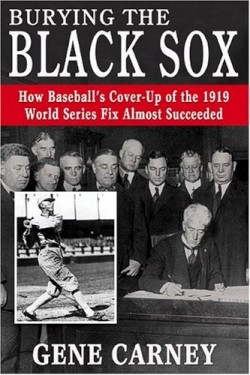
Burying the Black Sox
How Baseball&8217;s Cover-Up of the 1919 World Series Fix Almost Succeeded
“The scandal … was not ‘eight men out’ for throwing the series,” writes the author in his new take on the most notorious black mark against sports. “That is only how it went down in history. The scandal was that baseball was being preyed upon by gamblers.”
Almost ninety years after eight members of the Chicago White Sox—a.k.a. the “Black Sox”—were banned for life for conspiring to lose the 1919 World Series, authors and researchers are still looking for, and evidently finding, heretofore unexamined aspects of the games, the ensuing trial, and the continuing aftermath.
Chick Gandil, the team’s first baseman, was the nominal ringleader; other members of the player consortium included pitchers Eddie Ciccotte and Lefty Williams; shortstop Swede Risberg; centerfielder Hap Felsch; and utilityman Fred McMullen. Right fielder “Shoeless” Joe Jackson always admitted to taking his share of the money (most of which was never delivered to the athletes) but his statistics indicate that he may have played his best. And legend has it that the final member of the octet, third baseman Buck Weaver, was guilty only of not ratting out his teammates.
Rather than merely rehashing the story by focusing on the players and a few of the major gamblers involved, Carney focuses on the attempts by White Sox owner Charles Comiskey and baseball’s ruling class to deny and cover up allegations of wrongdoing, for the sake of baseball’s good name (and, of course, the continued patronage of the fans), even if that meant purposely misrepresenting communications with players and employing other tactics that seem to blur judicial propriety.
Then, as now, most decisions by management are economically driven. Fearing the loss of attendance the taint of gambling might bring, the owners effectively conspired and colluded to do all they could to keep negative impressions to a minimum. Unfortunately, Comiskey had enemies among the leagues’ executives, as well as the objective sporting press, who did not share in his phony altruism.
Carney has written about baseball since 1989, including Romancing the Horsehide: Baseball Poems on Players and the Game and numerous articles, reviews, poems, essays, and short fiction in publications ranging from USA Today’s Baseball Weekly to academic journals and small magazines. Here, he has done yeoman’s work in assembling his research. Arnold Rothstein, Sport Sullivan, and Billy Maharg are familiar names in the sad story, but the author introduces numerous characters on the periphery, names unfamiliar to all but the most ardent students of Black Sox culture. The depth and breadth is evidence of his passion for the topic. Carney also refutes previous works, such as Elliot Asinof’s Eight Men Out, one of the first books to examine the scandal, faulting the work for its anecdotal but uncited information.
The appendices include some unorthodox items, such as a description of the seven triples hit by the Cincinnati Reds (the Sox’ opponents in the 1919 fall classic).This volume is worth the price if only for the detailed notes and extensive bibliography.
Disclosure: This article is not an endorsement, but a review. The publisher of this book provided free copies of the book to have their book reviewed by a professional reviewer. No fee was paid by the publisher for this review. Foreword Reviews only recommends books that we love. Foreword Magazine, Inc. is disclosing this in accordance with the Federal Trade Commission’s 16 CFR, Part 255.
